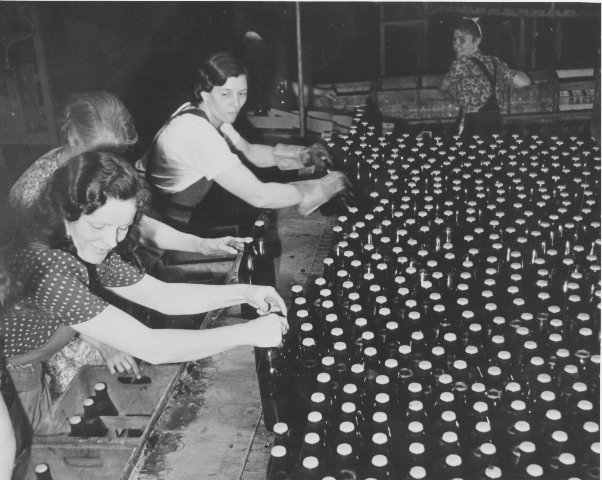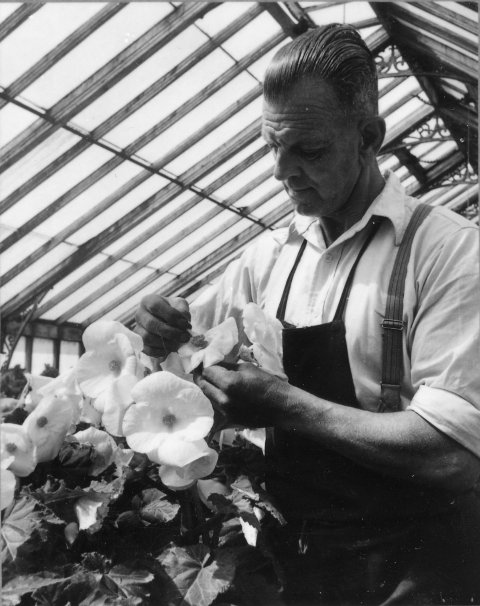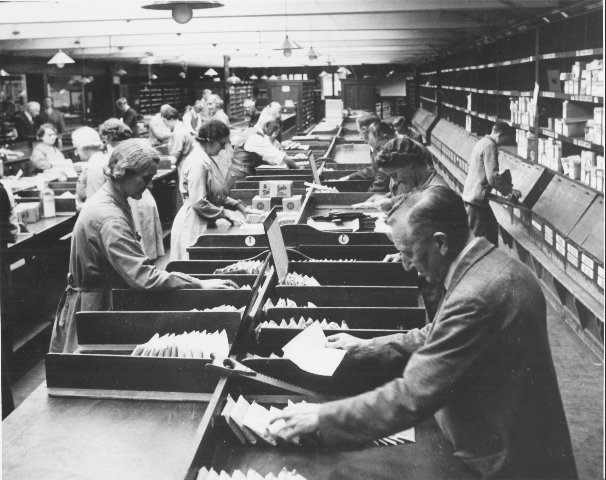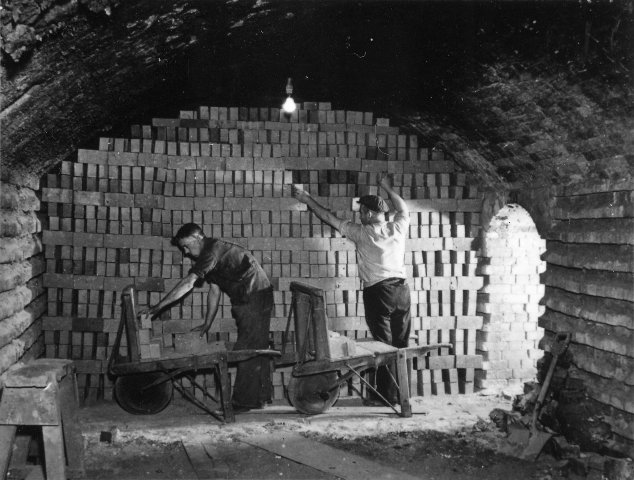Reading is known as the town of the three Bs - Biscuits, Beer and Bulbs. So far we have looked at the most important of these - Biscuits - but it would give a misleading picture to ignore the other Bs. They too played their part in the growth of the town.
Beer
This was the beer produced by Simonds Brewery, which was prominently situated in the centre of town, along either side of the Kennet. The site is now occupied by The Oracle shopping centre.

Women packing bottles of Simonds beer as they come from the pasteurising plant in 1945. (REDMG : 1946.52.26)
There was much trading of malt for brewing in Reading during the eighteenth century. Much of it was shipped on by barge to breweries in London. However, it was inevitable that beer should be brewed in Reading too - indeed most towns across the country had their own brewery until the mid twentieth century. By the late eighteenth century there were at least five breweries in Reading, producing 25,000 barrels of beer and porter annually.
Simonds brewery grew steadily
William Blackall Simonds established a brewery in Broad Street in 1785. The brewery grew steadily. In 1813 the firm began supplying beer to the Royal Military College. The young officers there obviously got a taste for Simonds beer because in 1872 the firm got the contract to supply the British Army with beer. Overseas branches in Malta and Gibraltar were formed to deal with army's needs. Like Huntley & Palmers the name Simonds came to have something of an international reputation.
Expansion, relocation, and survival
The brewery by the Kennet, like the Huntley & Palmers factory on the King's Road, grew to be large and complex site, employing a wide variety of trades - from coopers, to cashiers, farriers to filing clerks. The smell of hops lingered in the air, mingling with the smell of biscuits. However, in 1960 Simonds was taken over by Courage and in 1973 production was moved to a shiny new brewery on the edge of town, next to the M4 motorway. This site closed in 2010.
Bulbs
The third B is 'Bulbs' - a rather unconvincing allusion to Suttons Seeds. Suttons began life in 1837 when 'John Sutton & Son' began business. As with both Huntley & Palmers and Simonds the advent of the railway helped to facilitate the growth of the business. Suttons took pride in producing high quality seeds which, like the biscuits and beer, were exported all over the world. They even began supplying royal farms and gardens and their Reading headquarters were proudly named 'The Royal Seed Establishment'. At the turn of the century Suttons employed 2,000 people and had an annual turnover of 210,000 pounds.

A gardener pollinates a begonia at Suttons Seeds in 1945. Suttons Seeds' glass houses and seed testing grounds covered many acres on the outskirts of town (REDMG : 1946.52.37)
The headquarters building fronted Market Place, taking up much of the eastern side. Behind the grand offices facing the street there were six acres of sheds, where the seeds were packed. The seeds themselves were produced in large fields and greenhouses on the eastern edge of town. In the late nineteenth century passengers on Great Western trains passing through Reading could see both the large red brick biscuit factory, with its smoking chimneys, followed by dazzling fields of red, white and yellow flowers. However, in 1974 the company moved to Torquay, apparently because they found it difficult to get part-time workers.

Suttons Seeds order room in 1945 (Museum object no. 1946.52.41)
Bricks
To biscuits, beer and bulbs many would add a fourth B - bricks. Bricks and tiles have been made in Reading and the surrounding area since the medieval period. Tilehurst, once a hamlet near Reading, now a suburb, testifies to the antiquity of this industry in the area. By the nineteenth century there were many kilns in and around the town the largest of which - S & E Collier - was based in Coley. They moved to Grovelands in Tilehurst in 1870 and the firm remained in business until 1966. Reading's distinctive silver-grey bricks were made Poulton's at the Waterloo Kiln in Katesgrove, although this firm was bought by Colliers in 1906.

Packing a brick kiln at S&E Collier's brickworks in 1945. Collier’s were Reading’s largest brickmakers, they moved to Grovelands in 1870 and operated there until 1966. They were well known for their terracotta and ‘Reading Red’ bricks (REDMG : 1946.52.44)
Other notable businesses
All of these business - and others, such as the once celebrated Cock's Reading Sauce factory in the King's Road, or the Huntley, Boorne & Stevens tin factory in London Street - combined with Huntley & Palmers to make Reading a thriving place in the nineteenth century. Ironically, if Reading is known today it is not because of Suttons Seeds or even Huntley and Palmers biscuits, but because of Reading Prison, immortalized by Oscar Wilde's 'The Ballad of Reading Gaol'.

Cocks' Reading Sauce obtained a national reputation. In Jules Verne's 1872 adventure novel 'Around the World in Eighty Days' the hero Phileas Fogg breakfasts at London's Reform Club on 'broiled fish with Reading Sauce'. (REDMG : 2002.176.40)
Though Huntley & Palmers transformed modern Reading, the company ceased making biscuits here in the 1970s. So, what does Reading produce today?





